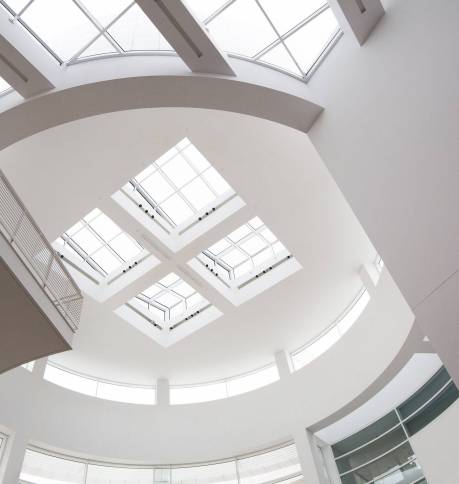

Imaging Procedure
What Is A CT Scan?
A computed tomography (CT) scan – also called a CAT scan – is a type of diagnostic test that combines X-rays and computer technology to provide views of soft tissue, bones and blood vessels. The technology creates sectional images, or “slices”, of the organs, tissues or vessels under evaluation.
- The name computed tomography is derived from the words tomos, meaning slice, and graphein, meaning representation.
- While CT uses X-ray technology, it is distinguished from other imaging tools like traditional X-ray and MRI by its ability to display a combination of soft tissue (like muscles, tissue, organs and fat), bones and blood vessels all in a single, 3-D image.
- CT technology was invented in 1972 by South African physicist Allan Cormack and British engineer Godfrey Hounsfield, who together won the Nobel Prize for their invention in 1979.
What is a CT scan used for?
Nearly every part of the body can be viewed with CT. The technology is frequently used to obtain a two-dimensional view of a cross section of the brain and other internal organs, such as the liver, lungs and spine. The technology is valuable in detecting tumors, bleeding, and other abnormalities that may not show up on an ordinary X-ray. Nearly one-third of all emergency department patients undergo a CT procedure.
What types of illnesses or injuries will a CT system detect?
CT can help diagnose head and spine injuries, lung and liver disease, cancer, tumors, blood clots, internal bleeding and a host of other diseases and injuries. The test is often used when fast diagnosis is critical – it can be lifesaving for auto accident victims and other emergency department patients.
How does CT differ from other diagnostic tests?
Unlike other imaging techniques, such as X-ray and MRI, CT has the ability to image a combination of soft tissue, bone and blood vessels. This capability proves very useful in evaluating the chest and the abdomen, making the modality a preferred method for diagnosing cancers such as lung, liver and pancreatic among others. Advanced CT systems also are being used extensively in detecting heart disease and other vascular conditions.
What happens during the scan?
During a CT exam, a patient lies on a table and is slowly moved into the large donut-shaped opening of the scanner. Once inside, a series of X-ray beams create hundreds of cross-sectional pictures that represent slices of the patient’s body. Seconds later, the system’s computer assembles the slices into the images that are interpreted by a radiologist.


How long does a CT scan take?
Depending on the exam you will receive, the length of the actual procedure may vary from as little as 30 seconds to as long 45 minutes. However, some of today’s most advanced systems – called multi-slice CTs – have the capability to perform exams faster than traditional systems.
Additionally, exams that used to be done on other types of equipment are now performed much faster using multi-slice CT. For example, diagnosing an appendicitis takes just 10 minutes using a multi-slice CT (compared to the standard 40-60 minute X-ray procedure). Multi-slice CT can also identify a kidney stone in 15 minutes, replacing the IVP exam – an invasive, uncomfortable, 60-minute X-ray exam.
What type of CT system will be used for my exam?
Your exam will be performed on a Siemens multi-slice CT machine. This particular Siemens multi-slice machine means means it can produce more precise images for more accurate diagnoses of injury and illness, in a significantly shorter amount of time.
What is the benefit of a multi-slice CT scanner for my exam?
Multi-slice CT is the fastest type of CT available today. It enables clinicians to perform standard CT exams in a fraction of the time, which means your exam will be finished sooner. As important, it provides much clearer images with even more anatomical detail than traditional CTs, which will aid your doctor in making a more accurate diagnosis. The speed of multi-slice also means that fast-moving organs like the heart and lungs can be imaged with CT for the first time.
Why did my physician order a CT exam for me?
CT is one of the most versatile diagnostic tools and is used to identify a variety of injuries, illnesses and diseases. Your doctor can explain why your CT exam was ordered.
Will I experience any pain during the CT exam?
No, not at all. CT is a painless test to enable physicians to view the internal organs and anatomy. However, some CT exams require patients to remain still during the scanning procedure, which for some may be uncomfortable.
What preparation is required before the exam?
Do not eat solid foods for three hours before the exam, but clear liquids and routine medications are fine. Patients undergoing an abdominal or pelvic scan are asked to drink an oral contrast, which makes certain internal structures easier to see during the exam. It tastes a bit chalky, but not unpleasant. For other exams, the contrast is injected instead of swallowed. Many exams do not require contrast at all. If there is a possibility you are pregnant, please let your clinician know.
Are there any side-effects or risks to a CT study?
The benefit of an accurate diagnosis far outweighs the risk. While CT does expose patients to radiation, it is equivalent to the amount of natural radiation we receive annually. Patients rarely have serious allergic reactions to the contrast medium but nursing mothers should wait for 24 hours before breast-feeding. If there is any chance you are pregnant you should let your clinician know.
Will I need additional tests after a CT exam?
While the answer will depend on the reason your doctor ordered your CT exam, we frequently perform multiple tests on patients to provide the physician with enough information to make an accurate diagnosis.
